what happens to a star when it runs out of hydrogen
Mail-Chief Sequence Stars
What happens when a master sequence star runs out of hydrogen in its core? The answers to this take usa along the next stage of stellar evolution. As with nigh stages in a star's life, the exact postal service-main sequence is primarily dependent on its mass. Nosotros will beginning past looking at what happens to a a one-solar mass star like our Sun and then explore what happens to college-mass stars.
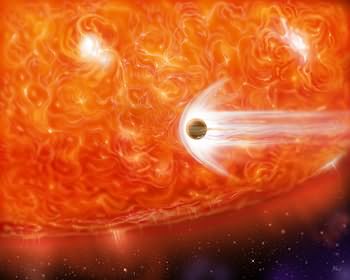
Credit: NASA
An artist'southward impression of a ruddy supergiant engulfing a Jupiter-like planet as it expands.
- Evolution of a Solar-Mass Star off the Main Sequence
- Cherry Giant Branch (RGB)
- The Helium Flash and Triple Blastoff Process
- Horizontal Branch (HB)
- Asymptotic Giant Co-operative (AGB)
- Evolutionary Tracks
- Evolution of High-Mass Stars Mail-Principal Sequence
- Development of Depression-Mass Stars Post-Master Sequence
1-Solar Mail service-Main Sequence Evolution.
Stars such as our Sun move off the principal sequence and up the cherry-red giant branch (RGB), fusing hydrogen into helium in hydrogen shell burning. A very short helium flash sees the kickoff of helium core fusion and the star moves along the horizontal branch (HB). One time beat temperature is sufficient, helium shell burning starts and the star moves upward into the asymptotic giant branch (AGB).
Moving Off the Main Sequence - Scarlet Giant Co-operative
A star remains on the principal sequence every bit long every bit in that location is hydrogen in its core that it can fuse into helium. And so far we have assumed that a star on the main sequence maintains a constant energy output. In fact, as a main sequence star ages its luminosity increases slightly, resulting in it expanding and its outer layer cooling. This explains why the main sequence is a broad band rather than a narrow line - stars move upwardly and to the correct on this band every bit they age.
Eventually the hydrogen fuel in the cadre runs out and fusion stops, shutting off the outward radiation pressure level. Inwards gravitational allure causes the helium cadre to contract, converting gravitational potential energy into thermal free energy. Although fusion is no longer taking place in the core, the rise in temperature heats up the shell of hydrogen surrounding the core until information technology is hot enough to kickoff hydrogen fusion, producing more energy than when it was a main sequence star. This so-called vanquish-burning causes some interesting effects.
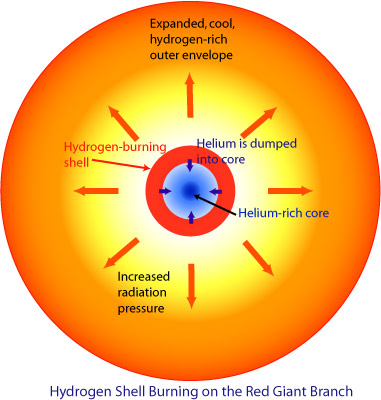
The new, increased radiation pressure actually causes the outer layers of the star to expand to maintain the pressure gradient. As the gas expands it cools, just as a spray can feels colder afterward apply as the gas has been released. This expansion and cooling causes the effective temperature to driblet. Convection transports the energy to the outer layers of the star from the shell-burning region. The star'south luminosity somewhen increases by a factor of grand × or so. During this phase of expansion, the star volition movement up and to the correct on the HR diagram forth the Cherry-red Behemothic Branch (RGB). A G (5)-class star may finish up as a high-Thousand or low-M luminosity form III giant.
A red giant displays extremes of density. The outer envelope is grossly extended and thus at a density below that of a vacuum on Globe. It is only weakly held by gravitational force to the residue of the star and easily ejected. Mass loss from a giant is typically about 10-seven solar masses per yr, compared with only 10-17 solar masses per yr currently for the Sun. Whilst the envelope is tenuous and absurd, the contracted helium cadre is incredibly dumbo. It is merely almost one-third its original size. Electrons within the cadre course a degenerate electron gas, they are packed tightly together in a book governed merely by the uncertainty principle. In this land information technology no longer behaves equally an ideal gas.
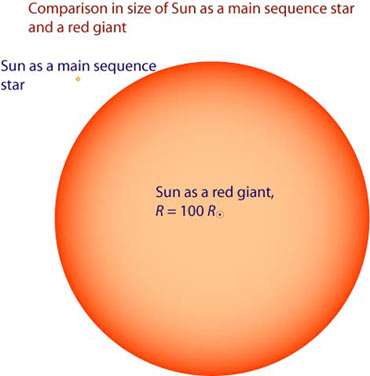
When the Sun becomes a red giant its radius volition be approximately 0.5 AU, that is nigh 100 × its electric current size.
Helium "Burning" and the Helium Flash
Hydrogen fusion in the shell produces more helium. This gets dumped onto the core, adding to its mass, causing it to heat upwardly fifty-fifty more. When the core temperature reaches 100 million K, the helium nuclei now have sufficient kinetic free energy to overcome the strong coulombic repulsion and fuse together, forming carbon-12 in a two-stage procedure. As three helium nuclei, as well known equally blastoff particles, are used it is called the triple alpha process. Subsequent fusion with another helium nucleus produces oxygen-16 nuclei. This process is the main source of the carbon and oxygen found in the Universe, including that in our bodies.
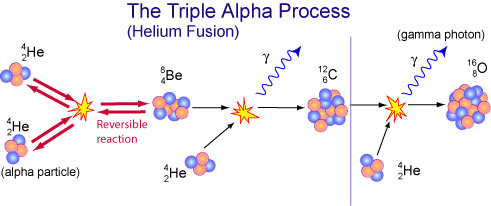
The triple alpha process for mail-principal sequence stars. Two helium nuclei (alpha-particles) fuse to course a beryllium-8 nucleus. This is unstable and normally decays back into two H-4e nuclei within a fraction of a 2d but given the high number of He-iv nuclei in the core will sometimes collide with one earlier it has had a chance to decay. This produces a carbon-12 nucleus and releases a gamma photon. The C-12 nucleus in turn may fuse with another He-iv nucleus to produce oxygen-16 and a gamma photon. Neon-20 may also be formed past oxygen nuclei fusing with helium only only negligible amounts are produced.
In stars with mass less than about ii-iii solar masses the triple alpha procedure initiates in a thing of minutes or hours. Once the temperature is hot enough for helium fusion in i role of the cadre, the reaction quickly spreads throughout it due to the behaviour of the electron degenerate gas. This sudden onset of helium cadre fusion (or "burning") is chosen the helium flash.
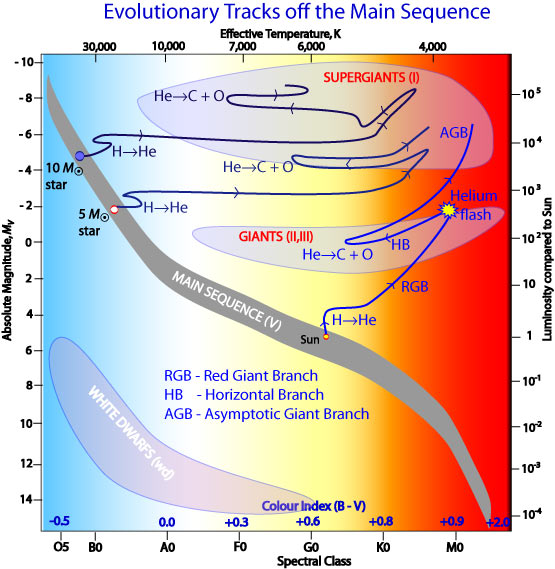
Postal service-principal sequence evolutionary tracks for ane, 5 and 10 solar mass stars.
The Horizontal Co-operative
The energy released by the helium flash raises the cadre temperature to the point where it is no longer degenerate. It thus starts to behave again as an ideal gas so can expand and absurd. Free energy transfers issue in a hotter outer layer of the star simply a smaller overall size. The rise in effective temperature and decrease in surface area are such that the luminosity remains roughly constant. Such a star tracks across to the left along the horizontal branch on the 60 minutes diagram. HB stars take helium core-burning and hydrogen shell-burning.
A solar-mass star has sufficient helium fuel for core-burning to last for about 100 million years.
The Asymptotic Giant Branch
Eventually all the helium in the core has fused into carbon and oxygen and then the core contracts once again. Carbon and oxygen nuclei accept more protons in them than helium does so the coulombic repulsion is greater. The temperature needed to fuse these into heavier nuclei must be even greater than the 100 1000000 K needed for He fusion. In stars of viii solar masses or less there is insufficient gravitational energy to generate the temperatures required. No more core fusion tin can thus take identify. The core contraction does yet generate sufficient heat for the surrounding layer of helium to beginning fusing, that is helium shell burning starts. Free energy from the helium-called-for in plough heats up surrounding unused hydrogen which also starts shell burning.
The behemothic star expands once again, perchance upwards to 1.5 AU, equivalent to the orbit of Mars. It is now an asymptotic behemothic branch star (AGB), occupying the upper-right portion of the Hr diagram. A i-solar mass AGB may have a luminosity x,000 × that of our current Sun. Mira (ο Ceti) is an instance of an AGB star.
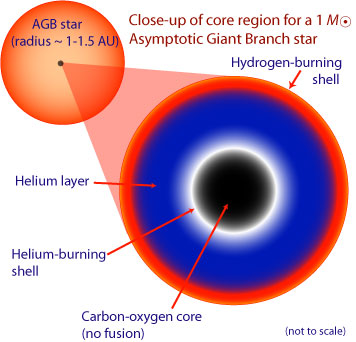
Outer layers of AGB stars are only weakly held by gravity. The helium-burning crush is non dense enough to be degenerate and so helium flashes occur with a runaway temperature rise. The resulting increased reaction rate generates a large energy release or thermal pulse for a couple of hundred years. During this phase nuclei within the helium-called-for shell tin can exist synthesised into heavier nuclei through the capture of neutrons and radioactive beta decay. This and so-called s-process (s for slow, in comparing with the rapid, r-procedure that occurs in more massive stars) produces elements as heavy as bismuth with 83 protons. AGB stars may produce a thermal pulse every 10,000 - 100,000 years.
Big convection currents in AGB stars deport material produced in the thin helium-burning beat upwards to the surface. These heavier nuclei are detected in the star's spectrum which thus provides an insight on what is happening deep inside the star. Every bit with RGB stars, the radiation pressure tends to blow away much of the tenuously-held outer layer. The charge per unit of mass loss is an order of magnitude higher though starting at nearly 10-half-dozen solar masses per year. As the star evolves upward the AGB co-operative, pulsations increase the rate of mass loss upwards to nigh 10-4 solar masses per twelvemonth.
The ejected material comprises a mixture of elements including carbon and oxygen dredged upwards from within the star. Carbon-rich molecules form dust and soot particles that tend to shroud the actual star. Every bit the cloud expands it cools but the grit absorbs and re-emits the radiations from the star at longer wavelengths. AGBs are thus often more luminous in the infrared than visible wavebands. The expanding cloud can as well be observed at radio wavebands.
AGBs such as Mira are intrinsic variable stars with periods of months or a few years. They tin can vary by up to x magnitudes. Mira'southward radius differs by a factor of two during its oscillations.
What happens to solar-mass stars in one case fusion is completed is discussed on the next page.
High-Mass Post-Chief Sequence Evolution.
Evolution of high-mass stars off the principal sequence is an involved process and one yet not fully understood. Such stars are rare and have very curt lifespans relative to lower-mass stars. Supergiants such as Betelgeuse, Deneb, Rigel and Antares are some of the most prominent stars in our sky and visible over vast distances due to their extreme luminosities. This section provides a bones outline of the stages.
Loftier-mass stars swallow their core hydrogen at biggy rates so may but survive on the main sequence for millions rather than billions of years. Once this fuel is used upward, the core contracts due to gravity and heats upwards. This triggers helium-burning in the core. Unlike lower-mass stars, this helium fusion (triple-alpha process) starts gradually rather than in a helium wink. In moving off the main sequence, the effective temperature of the star drops as its outer layers aggrandize. The decrease in temperature balances the increased radius so that the overall luminosity remains essentially constant. Evolutionary tracks for these massive stars thus motility horizontally across the supergiant region of the HR diagram every bit shown on the diagram to a higher place. The free energy liberated past helium fusion in the cadre raises the temperature of the surrounding hydrogen shell so that it also begins fusing.
The size of these supergiants is enormous. Betelgeuse, thought to be between 13 and 17 solar masses, is so large that its envelope would extend across the orbit of Jupiter if it replaced our Sun. Its angular size is and then large that information technology tin exist directly imaged by the HST.
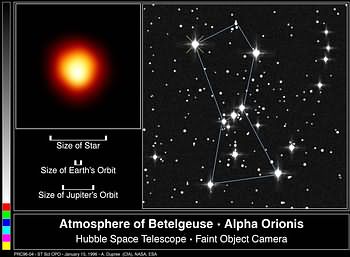
Credit: Andrea Dupree (Harvard-Smithsonian CfA), Ronald Gilliland (STScI), NASA and ESA
Betelgeuse is a cherry supergiant. The bright yellow spot at the bottom of the star is thought to exist a hotspot due to a massive convection cell.
In stars of 5 solar masses or higher, radiations pressure rather than gas force per unit area is the ascendant force in withstanding collapse. The mass is large enough that the gravity interim on the core after helium-burning is sufficient to produce temperatures of 3 × 108 K where fusion of carbon with helium to produce oxygen dominates. A star of 8 solar masses or more can continue to synthesise even heavier elements in the core.
Gravitational core contraction after all the core helium is used upward generates a temperature of virtually five × x8 Thousand at which signal carbon nuclei fuse together to produce sodium, neon and magnesium. Production of magnesium releases a gamma photon, that of sodium releases a proton and neon produces a helium nucleus. One time all the core carbon is consumed, further collapse pushes temperatures to most tennine Grand. At this temperature, reactions that release gamma photons, such as 16O + 4He → 20Ne + γ, may be reversed by a process called photodisintegration. Helium nuclei released via this procedure can fuse with other neon nuclei to produce magnesium.
One time the neon is used upwardly, core wrinkle increases the temperature to 2 × ten9 K where 2 oxygen nuclei fuse to form silicon. This in plow may undergo photodisintegration to form magnesium and helium nuclei that so fuse with other silicon nuclei to produce sulfur. Like stages of reactions see sulfur produce argon and argon synthesise calcium. Somewhen elements such as chromium, manganese, fe, cobalt and nickel may be produced. Ultimately the silicon in the core is converted, every bit silicon-called-for, into iron with final core temperature reaching about 7 × 109 K. The core region of a supergiant thus resembles the layers of an onion with a dense fe cadre surrounding by shells of silicon and sulfur, oxygen and carbon, helium and an outer vanquish of hydrogen as shown in the diagram below.
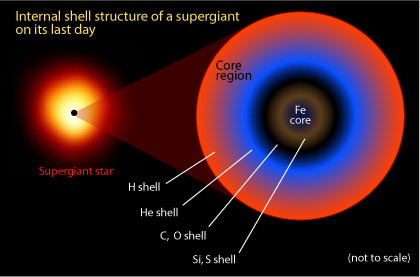
The onion-like layers inside a supergiant in the final stages of its life. Successive layers represent to the unlike elements produced by fusion, with a dense core of iron at the centre.
Nucleosynthesis of elements above helium is less efficient so that each successive reaction produces less free energy per unit mass of fuel. This means that the reactions occur at greater rates and so that radiation pressure level balances gravity. Whilst a massive star may spend a few meg years on the main sequence, its helium core-burning stage may exist a few hundred thousand years. The carbon burning phase lasts a few hundred years, neon-burning phase a year, oxygen-burning half a year and the silicon-burning only a day.
These massive stars evolve extremely rapidly once they move off the main sequence. Statistically they are very low in numbers every bit they are less likely to form than lower-mass stars and their lifetimes are so curt anyway. Every bit nosotros shall run into in a after section, they also make dramatic exits.
Low-Mass Postal service-Principal Sequence Evolution
Every bit discussed previously, depression mass stars consume their core hydrogen at much lower rates than stars such as our Sun. Their main sequence lifespans are tens to hundreds of billions of years. Once they have consumed their cadre hydrogen, gravitational core collapse causes the core to heat up. For stars with less than 0.5 solar masses nonetheless, their is insufficient mass to generate the temperatures need for the helium in the core to start fusing. A brief period of hydrogen-shell burning sees its luminosity rise as with higher-mass stars. Unable to release energy from helium fusion, H-beat out burning does not last long. The star's luminosity quickly decreases and the star cools downwards. Its evolutionary track crosses dorsum beyond the main sequence and down.
Source: https://www.atnf.csiro.au/outreach/education/senior/astrophysics/stellarevolution_postmain.html
0 Response to "what happens to a star when it runs out of hydrogen"
Post a Comment